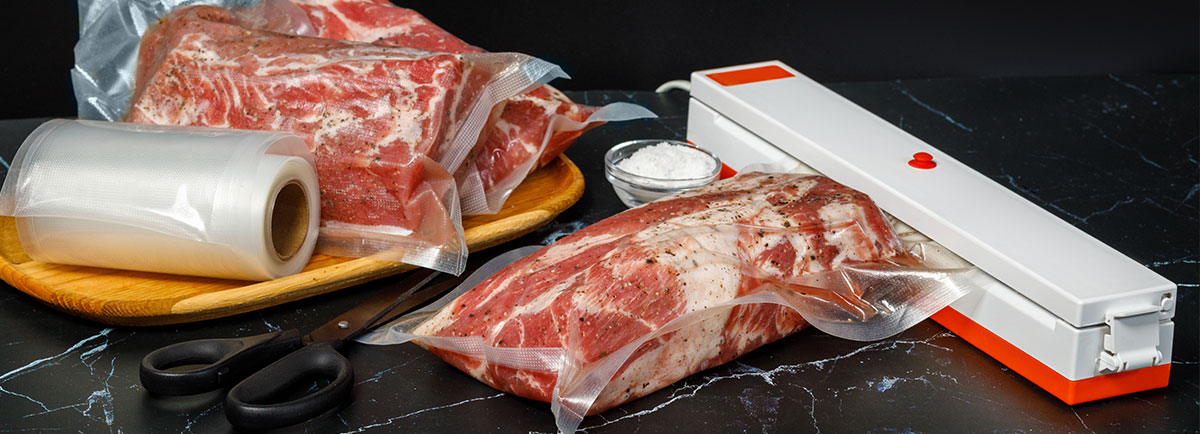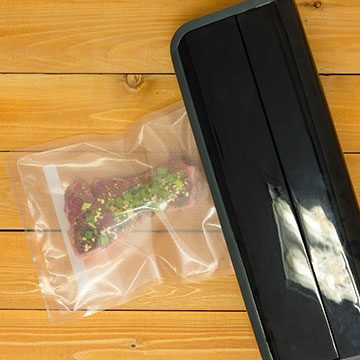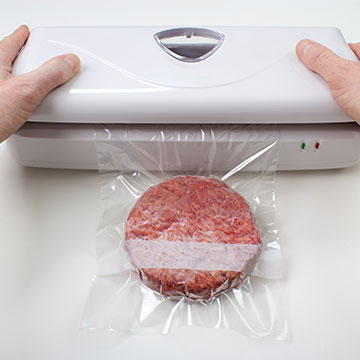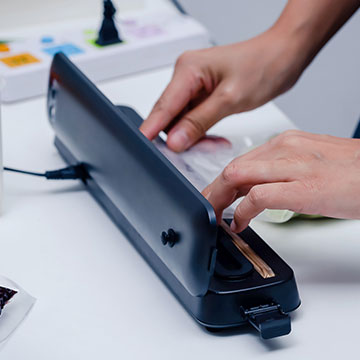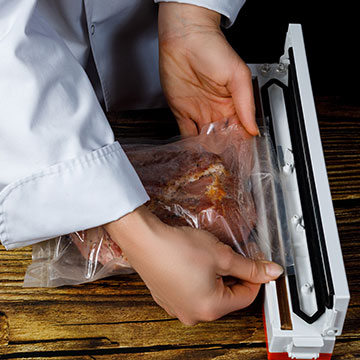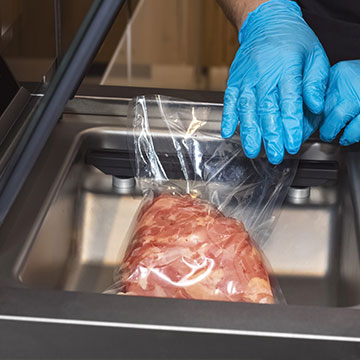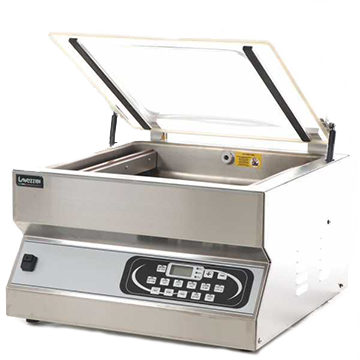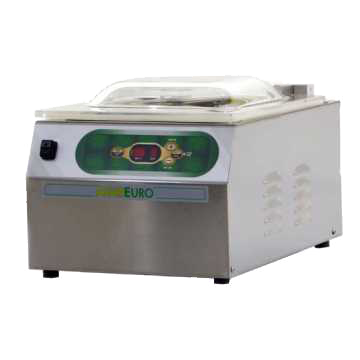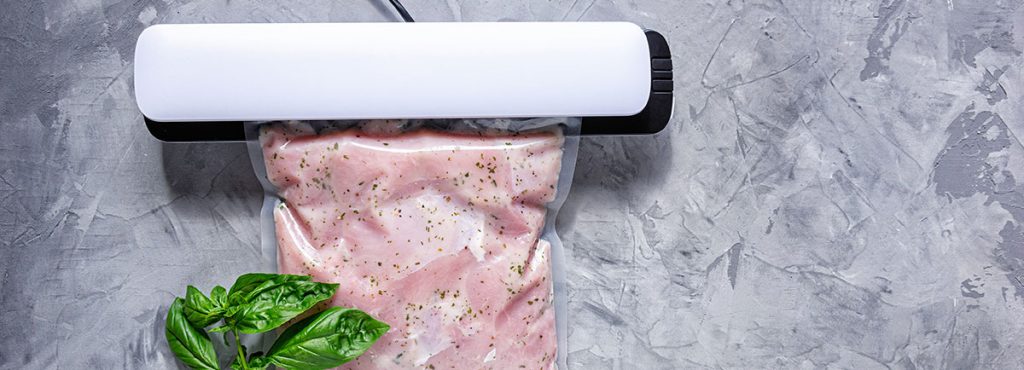A comprehensive guide to purchasing vacuum sealers, covering all the various models and their correct use for proper storage.
The Complete Guide to help you choose the Best Vacuum Sealer
by the Real Experts of Kitchen Equipment
How many times have we bought fresh foods at the supermarket, only to return home and not knowing how to store it? How many times have we prepared plenty of food for our family or friends, only to find that our fridge and freezer are full to the brim?
Especially at this particular time, when people are trying not to leave their home too much, going to the grocery store less frequently but buying large quantities of food, the organization of the fridge or freezer has become a very complex task. This is why it is worth considering all the existing options for keeping food well preserved, fresh and unaltered.
Good storage of food, from vegetables to meat, from cheese to cured meats, is essential both to avoid losing the aromas and beneficial properties of the food and for a reason closely linked to our health.
Freezer storage, drying, preserving in jars in oil or vinegar, and so much more: there are many ways of preserving food, but of all the known methods, there is one that can perfectly preserve all the organoleptic characteristics of food. We are talking about vacuum-packing, a relatively modern preservation technique compared to others, which is widespread throughout the world because of its simplicity and efficiency.
Vacuum-packing allows to preserve food and keep its taste and aroma intact for long periods, sometimes longer than freezing or other food preservation methods.
Are you planning to buy a vacuum sealer to preserve food for longer, but you don’t know which one to choose? What could be the best model?
This purchasing guide will shed some light on all the doubts and uncertainties about these tools and help you choose the right vacuum packing machine that best suit your needs.
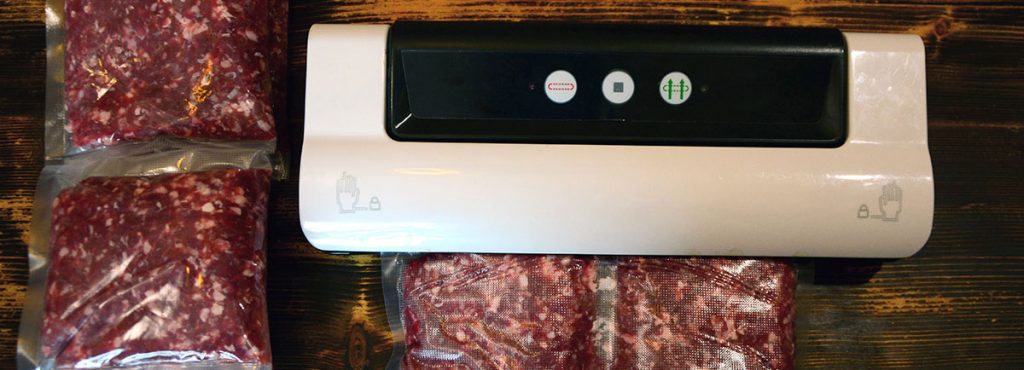
Food vacuum sealing machine with external suction
CONTENTS
1. What is the meaning of “vacuum”?
The expression “vacuum storage” means the process of eliminating almost all the air inside a container.
In the food sector, vacuum storage is a conservation technique that drastically slows down the deterioration of food in order to preserve all its organoleptic qualities and avoid the proliferation of bacteria.
By creating a vacuum inside the container, we directly affect the shelf life of the vacuum-packed product, eliminating the onset of mould or bacteria and ensuring that the food retains its properties.
The removal of oxygen eliminates an important oxidising agent, the same one that produces browning and alteration of the food.
2. Five reasons to buy a vacuum sealer
For over 10 years now, vacuum sealing machines have become increasingly widespread and popular, but what are the real benefits that made this small tool more and more present in domestic kitchens?
Compared to other methods of preservation, the vacuum packaging:
- IS COST-EFFECTIVE (AND ECOLOGICAL)
Choosing to buy a vacuum sealer allows to avoid unnecessary waste, with significant economic advantages.
Let’s compare, for example, a user who buys only large pieces of meat for a whole year, then cuts the meat into portions suited to his/her eating habits and vacuum packs them all, with another user who hits the grocery store pretty often and buys only meat preserved in plastic packaging. Leaving the obvious economic difference between the two methods aside, it is evident that in one of the two cases there is a much smaller accumulation of useless plastic packages, and consequently a substantial contribution to environmental protection, as well as significant cost savings. - IS MORE EFFECTIVE AND EXTENDS STORAGE TIMES
Compared to other techniques, this type of conservation allows food to remain preserved five times longer, retaining all its properties, unlike other methods, such as in the case of freezing in non-optimal conditions, which leads to food spoilage due to a very widespread phenomenon called “freezer burn”. This can happen in a number of circumstances: when, for example, the freezer does not maintain a constant temperature (due to technical problems related to the appliance because we make a wrong use of it, such as when the door is left open for too many seconds), or when the food remains in the freezer for too long, or even when the it is frozen with the wrong packaging. - IS MORE HYGIENIC
It drastically reduces the proliferation of the bacteria due to poor food storage. By deoxygenating the product, the microorganisms on it are almost totally eliminated, ensuring a healthy and safe food.
Please note: Beware of botulinum! Although the vacuum sealer is undoubtedly a safe and reliable product for food preservation, it is not able to eliminate the possible onset of the botulinum neurotoxin in food. - IS SPACE SAVING
Needless to say: vacuum-packing is a really useful solution for all those who do not have the possibility of storing food in large enough refrigerators or freezers.
With this efficient system, the management of food storage spaces will be extremely easy! - IT BETTER PRESERVES THE NUTRITIONAL PROPERTIES OF FOOD
All foods that are rich in vitamins and minerals, such as fruit and vegetables, if vacuum-packed, will not lose their beneficial properties and will remain nutritionally unaltered.
3. Operation and use
In general, the operation of a vacuum sealing machine is very easy and straightforward.
For example, vacuum sealers for domestic use with external suction, are smaller in size compared to the other heavy-duty versions and are extremely easy to use, as they are designed to be user-friendly and prove to be within reach of even less-experienced users or beginners.
Let’s start from the very first step, which is the insertion of the food inside the container, which, in the case of sealing machines for domestic use, is most probably a bag.
The food must be placed precisely and carefully inside the bag, if possible in a central position, keeping the food a few centimeters away from the end of the bag, so that the machine can perfectly draw the air in without damaging the food.
Before going any further, make sure that the area where the heat from the sealing bar will be acting is clean and free of irregularities that could obstruct the correct sealing of the packaging.
Once this is done, take the two edges of the bag (i.e., the open side of the bag), and place them in the suction hole, where the sealing bar is located.
Once having positioned the bag edges correctly along the sealing bar, start the machine. This will activate the aspiration process of the oxygen that is present in the bag, through the pump, which will remove the air.
Once the vacuum packing machine, has reached the maximum suction level, it will stop the vacuum process and start sealing the edges by means of the sealing bar, which will hermetically seal the bag.
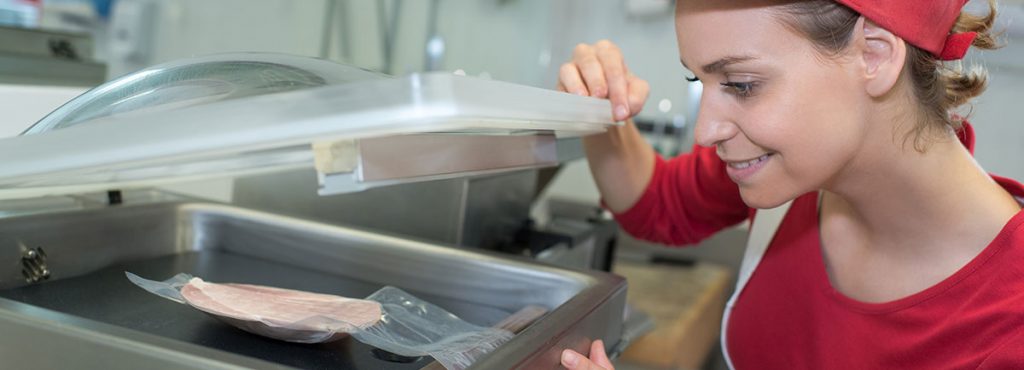
As for other types of vacuum packing machines, more professional and performing, such as the chamber vacuum machine, the process is basically the same: the food goes into a bag, inside which a vacuum is created by the pump, then the bag is sealed thanks to the heat of the sealing bar.
The only difference between the two types lies in the fact that the machines with external suction do not have a vacuum chamber, hence the bag is placed outside the machine, while in chamber vacuum machines, the bag must be placed on the inside of the appliance and the sealing bar is located on the lid, which must be pulled down to its complete closure, before proceeding with the aspiration and sealing processes.
4. Types
As we already mentioned in the previous section, on the market there are two main types of vacuum sealers: those with external suction, more compact, cost-effective and designed for domestic and non-professional use (even if some models can guarantee levels of efficiency comparable to high-end models) and chamber vacuum machines (or with internal suction), more expensive and mainly suitable for professional/industrial use.
4.1 With external suction
Exactly as shown in the example on section 3, vacuum sealers equipped with this type of aspiration system, are designed for a purely domestic use and come with a much more affordable price, which can vary according to the characteristics, as well as, of course, size and construction materials.
Unlike heavy-duty chamber vacuum machine models, these vacuum sealers are unable to reach absolute vacuum, but only an amount hovering around 80-85%. This results in a lower preservation of the food as the percentage of oxygen that remains trapped in the package with the food reduces the shelf life of the vacuum packed product.
External suction vacuum packing sealers are characterised by the fact that the bag, inside which the vacuum is created, remains outside the machine, leaving only a small flap along the sealing bar.
Vacuum sealers with external suction are designed to be used with solid products only. The reason for this lies in the fact that vacuum-packing bags with liquid products inside could compromise the operation of the vacuum sealing machine itself, as a small amount of liquid could be drawn in by the machine to the point where it stops working.
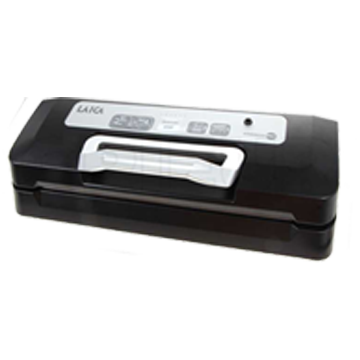
Plastic vacuum sealer
with external suction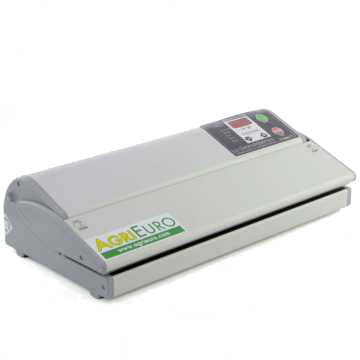
Aluminium vacuum sealer
with external suction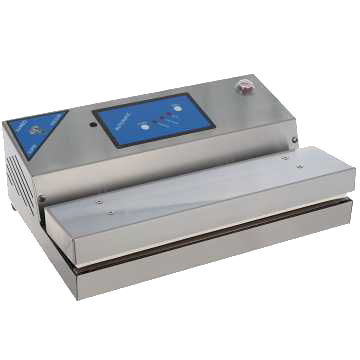
Stainless steel vacuum sealer
with external suction
4.2 Chamber vacuum machines
In addition to substantial differences in price, materials (usually stainless steel), functionality and vacuum quality, vacuum sealing machines with internal suction differ from the others in terms of shape, weight and structure.
In fact, chamber vacuum machines are equipped with an internal vacuum chamber, in which the bag is placed, and are able to reach almost an absolute vacuum (99%).
As we mentioned above, this type of machine can boast many advantages compared to other types:
- Vacuum-packing of liquids and semi-liquids
The great benefit of these special vacuum sealing machines is precisely the possibility to vacuum pack even less solid or even liquid foods, like tomato sauce, juice, fruit or vegetable centrifuged, sauce and so on.
Unlike normal machines with external suction, these models do not need special containers to be put into function, as standard vacuum bags normally used with other vacuum sealers are perfectly suitable. - Greater vacuum
These models are capable of drawing in up to 99% of the air contained in the bags, thus ensuring a greater vacuum-packing and, as a consequence, a better preservation of foods. - Suitability for sous-vide cooking
All foods processed with these heavy-duty vacuum sealers are perfectly suitable for sous-vide cooking. In fact, in order to carry out this type of cooking, it is necessary to achieve a very high level of vacuum (close to 100%), which is only reachable with heavy-duty chamber vacuum machines.
5. How to choose it?
5.1 The pump
The fundamental element of a vacuum packing machine is the pump, the mechanism that creates the vacuum by drawing in the oxygen contained in the bag or container.
In order to fully understand its importance, it should be considered that the greater the vacuum achieved by the machine, the less will be the oxygen left in the sealed bag and, consequently, the longer the shelf life of the food.
The vacuum value is expressed in bar and, in general, a good vacuum sealer for domestic use has a vacuum value of around 600 bar, while more professional models can reach up to 800-900 bar (almost an absolute vacuum).
Therefore, when purchasing, it is essential to bear in mind both the maximum vacuum that the machine is able to create on the food product and the actual suction power.
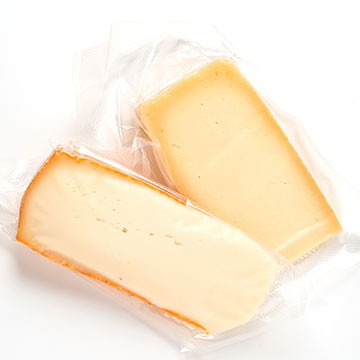
Vacuum-packed semi-cured cheese 
Vacuum-packed vegetables 
Vacuum-packed bell peppers
5.2 Power
As we have mentioned above, another very important factor in choosing a vacuum packing machine is the power, i.e. the ability of the machine to exert pressure on the bag or container through the diaphragm pump, but also the sealing effectiveness of the bar.
It is clear that the higher the power of the machine, the greater the end result.
Power is expressed in Watt (W).
5.3 The flow rate
One of the most important parameters is the flow rate, i.e. the speed at which the machine draws the air out of the container.
The flow rate is closely related to the pump power of the vacuum sealer and, consequently, to the actual performance of the machine.
As a rule, the flow rate is indicated in litres per minute (L/min) and, in general, a good quality vacuum packing machine comes with a flow rate ranging between 8 and 20 L/min.
In more sophisticated models, there is the possibility of setting a “softer” and more gradual suction speed, recommended for all those foods which are soft or too fragile for a high flow rate vacuum-packing. A machine with a lower flow rate, in fact, will ensure that the food is kept intact and undamaged.
5.4 Functions
The many functions with which vacuum sealers are equipped prove to be very useful to comply with particular food preservation needs or to vacuum-pack foods that have certain characteristics.
There are many functionalities, many of which vary according to the level of vacuum, the sealing time and the suction flow rate exerted on the product.
Among the main functions that a good vacuum sealing machines should not be lacking are:
- The adjustment of the sealing time: very useful when there are many bags to seal and the sealing bar is already hot and does not require additional energy to release the heat needed to seal;
- The sealing bar temperature control: extremely convenient for the same reason as the previous function, but also to prevent less resistant bags from being damaged by an excessive sealing temperature;
- The manual sealing, that is, the ability to seal bags normally, without vacuum-packing them. It is a function that only seals the bag, which turns out to be really practical if you need to save the freshness and fragrance of some foods;
- Wet food cycle: this function is particularly recommended for all foods that tend to release juices, such as meat;
- Fragile food cycle: this function is suitable for all foods that could be broken or damaged by excessive and rapid suction;
- Bags/containers cycle: this cycle is designed to create a vacuum inside the containers provided with the machine as accessories.
5.5 Size
Particularly for users looking for a model for home use, the size can not be overlooked.
On average, a vacuum sealing machine for domestic use is not very bulky and ranges from 30 to 45 centimetres. Although their are not particularly bulky machines, there are models that can be arranged horizontally and/or vertically, depending on the user’s requirements.
When it comes to the dimensions of the machine, it is important to take into account the size of the sealing bar. It goes without saying that a small-sized machine will not have a very versatile sealing bar; on the contrary, larger vacuum sealers will be able to seal bags of different sizes, from the smallest to the largest.
For example, domestic models will have a sealing bar that is unlikely to exceed 35 cm, unlike the more heavy-duty ones that can reach up to 80 cm.
5.6 Materials
As in most household and kitchen appliances and tools, the materials are extremely important and can make a difference.
As for heavy-duty models, most of them are made of stainless steel, which is stronger and more suitable for the intended use, while the common household models are mostly made of PVC, plastic or aluminium.
5.7 Accessories
Finally, there are the accessories. Some of the most common are:
- The reusable vacuum bags,
- Bags for low temperature sous-vide cooking.
- Connections to create vacuum in jars,
- Lids to create vacuum in glass bottles,
- Containers along with the tube and connection,
- Vacuum rolls of various sizes to make customised bags according to the user’s needs,
- Bag cutters to cut bags into custom sizes.
6. Brands
The world of vacuum sealers is very wide and there are many products from many different brands, some more reliable and others less so.
Among the brands we recommend considering when it comes to purchasing a vacuum packing machine, whether for domestic or professional use, there are: Reber, Tecla, R.G.V., Beper, Laica, Macom, FoodSaver, Tre Spade, Magic Vac and Orved.



